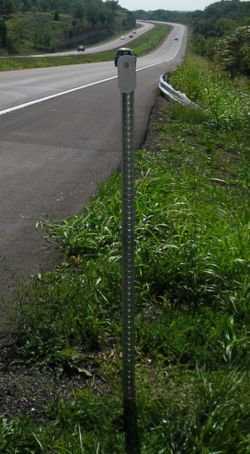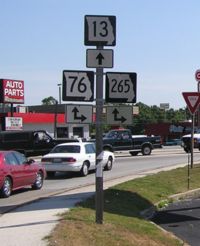Difference between revisions of "903.17 Delineation and Object Markers"
m (additional links to EPG 620.3) |
m (article construction) |
||
| Line 10: | Line 10: | ||
==903.15.3 [[620.3 Object Markers (MUTCD Chapter 3C)|Type 1 Object Marker]]== | ==903.15.3 [[620.3 Object Markers (MUTCD Chapter 3C)|Type 1 Object Marker]]== | ||
| − | The Type 1 Object Marker is used to mark obstructions within the roadway. Where other signing such as Keep Right signs or Double Down Arrows is used to mark the obstruction, the Type 1 Object Marker is not needed. However, if additional emphasis is needed, this object marker may be used with other signs. The Type 3 Object Marker's total square footage is tabulated in the SHR2L-1 column on the D-30 sheet. | + | The Type 1 Object Marker is used to mark obstructions within the roadway. Where other signing such as Keep Right signs or Double Down Arrows is used to mark the obstruction, the Type 1 Object Marker is not needed. However, if additional emphasis is needed, this object marker may be used with other signs. The Type 3 Object Marker's total square footage is tabulated in the [[903.4 Guide Signs#903.4.1.5 Legend Types|SHR2L-1]] column on the D-30 sheet. |
==903.15.4 [[620.3 Object Markers (MUTCD Chapter 3C)|Type 2 Object Marker]]== | ==903.15.4 [[620.3 Object Markers (MUTCD Chapter 3C)|Type 2 Object Marker]]== | ||
Revision as of 06:52, 22 October 2008
Contents
903.15.1 Delineators
Refer to Standard Plan 903.03 for delineator placement and use. Delineators are placed on all divided highways, expressways, non-interstate freeways and interchanges. It is not necessary to spot each delineator on the sign location plan, unless the geometrics are unusual, and placement is not readily apparent when referencing the standard plans. Totals are estimated and shown on Form D-29.
903.15.2 Object Markers
Object markers are used to mark obstructions within or adjacent to the roadway. They are normally mounted 4 ft. (1.2 m) above the travelway to the bottom of the sign. Refer to 620.3 Object Markers for additional information.
903.15.3 Type 1 Object Marker
The Type 1 Object Marker is used to mark obstructions within the roadway. Where other signing such as Keep Right signs or Double Down Arrows is used to mark the obstruction, the Type 1 Object Marker is not needed. However, if additional emphasis is needed, this object marker may be used with other signs. The Type 3 Object Marker's total square footage is tabulated in the SHR2L-1 column on the D-30 sheet.
903.15.4 Type 2 Object Marker
The Type 2 Object Marker is used to mark obstructions adjacent to the roadway or travelway that are so close they may pose a hazard. These objects include underpass piers and bridge abutments. In some cases, there may not be a physical object involved but other roadside conditions such as narrow shoulder drop-offs.
903.15.5 Type 3 Object Marker
This object marker may be used in lieu of Type 1 or Type 2 Object Markers. Type 3 Object Markers are installed so the stripes are angled downward toward traffic.
903.15.6 Type 4 Object Marker
The Type 4 Object Marker is used at a road terminus. Three object markers are placed across the end of the road spaced 6 ft. apart. Type 4 object markers are also used to supplement barricade boards and should be done so according to Standard Plan 903.02.
903.15.7 Route Marker Shield Assemblies
Refer to 903.7.29 for a number of examples of proper placement of route marker assemblies. These assemblies for independent use are SHR1L-1 signs. For interstate shields, payment is the same but these contain blue sheeting. For cardinal directions placed over the interstate shield, a note is placed on Form D-30 to indicate the number of cardinal directions which are interstate design, and which are the black on white type. This is also indicated for arrow signs placed below the interstate shield. For overlapping routes with an interstate and any other type of roadway containing the same cardinal direction, only one cardinal direction is required, and one arrow sign, with the interstate design being used, as indicated on typical signing plans for diamond interchanges and cloverleaf interchanges.
Cardinal direction sheet signs are 30 in. wide for 30 in. wide interstate shields. Cardinal direction signs are used above independent shields of lettered routes, business loops, or advance intersection assemblies that contain a junction sign.

